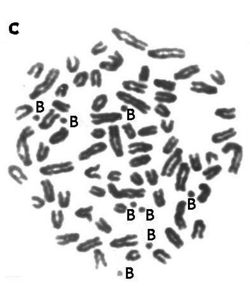B chromosome
From CreationWiki, the encyclopedia of creation science
Jump to navigationJump to search
B chromosomes (also known as supernumerary[1] or accessory chromosomes) are additional to the normal basic chromosome set (called A-chromosomes). B chromosomes are 'extra' dispensable segments of DNA that do not recombine with the A chromosomes of the regular complement.[2] B-chromosomes occur widely in flowering plants occurring in over 1000 plants and also in at least 260 animal species.[3] Supernumerary chromosomes lacks functional genes, and feature an irregular, non-Mendelian, mode of inheritance.
References
- ↑ Griffiths, Anthony J. F.; Wessler, Susan R.; Lewontin, Richard C.; Carroll, Sean B (2008). Introduction to Genetic Analysis (9th ed.). New York: W. H. Freeman. p. 609. ISBN 978-0-7167-6887-6.
- ↑ Jones, Neil; Houben, Andreas (September 2003). "B chromosomes in plants: escapees from the A chromosome genome?". TRENDS in Plant Science (Elsevier) 8 (9): 413-423. ISSN 1360-1385.
- ↑ Clark, M. S.; Wall, W. J (1996). Chormossomes: The Complex Code. London: Chapman & Hall. p. 61-63. ISBN 0-412-75210-7.
| |||||||||||||||||

